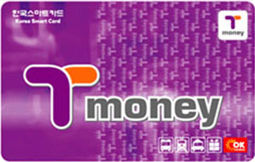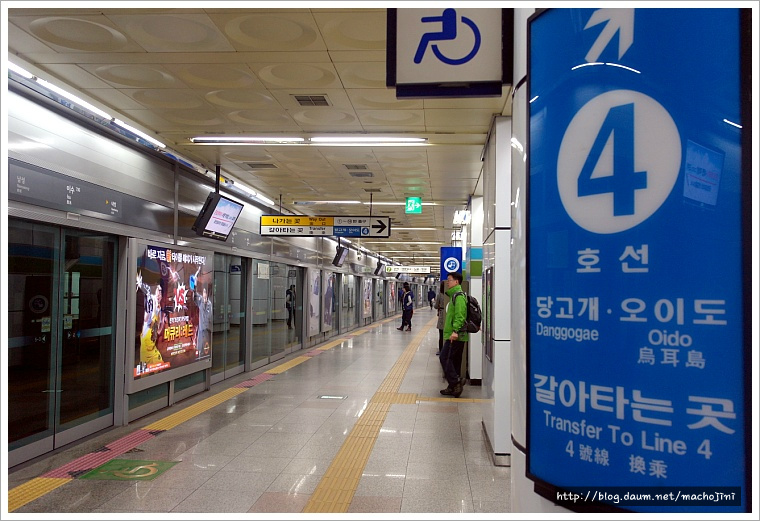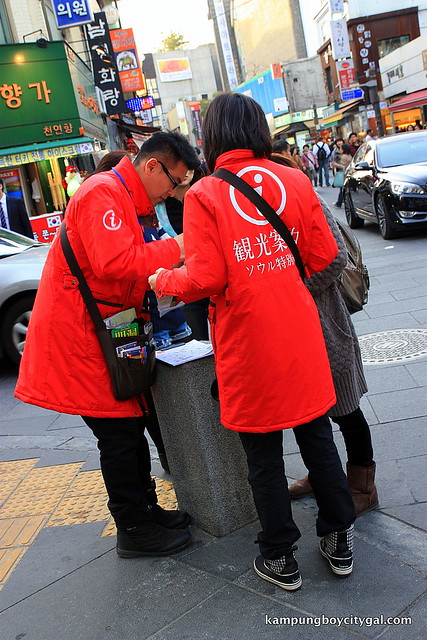1. T-Money(티머니 )
Get a T-Money card at a subway station, the card costs 2500 won and you can recharge it at any subway station or mart. You can even buy drink or stuff at a mart with your T-Money. Besides, you'll get a little discount if you use T-Money to swipe for the subway ticket instead of using cash to buy the subway ticket.
2. Keep a subway map, always (지하철 )
Get a Seoul subway map, and study it before you start your journey. Study as in plan your journey on which route/subway line you're taking and which exit(나가는 곳) you'll be going out from.
Example: Subway Line 5(5호선) , go out at Exit #2 of Ganghwamun Station(광화문역 ). Walk 400 meters.
Each subway station could have several exits that would lead you
to different places. For an example, in Myeong Dong station(명동역), if you get
out of exit 1 or exit 2, you would be at the opposite side of the road.
Image credit:ddanzi.com
You
could also download Jihachul(지하철), smart phone apps for Korean subway station(available on both iPhone and Andriod).
Some of the subway station have interchanges, which is abit confusing. You don't have to totally exit the subway station to go to another subway line, it's built within the subway, there will be sign board showing 'Transfer to Line 2'(갈아타는 곳) . just follow the signboards and arrows, and you'll reach the 'Line 2' subway station.
Read more here: Seoulistic
Get the huge Seoul Subway Map: Here
3. Learn some simple Korean language
For an example:
Where is the toilet?
화장실이 어디에요?(hwajangsil-i eodieyo)
How do I get to ______ .
_______ 에 어떻게 가면 되나요? (_____e eotteohge gamyeon doenayo?)
Please give me this.
이거 주세요(igeo juseyo)
How much is this?
이거 얼마에요?(igeo eolma-eyo?)
Thank you
감사합니다(gamsahabnida)
4. Don't hesitate to ask for directions
Koreans are very friendly, and willing to help. From my personal experience, me and my friends got lost in Namsan-dong(남산동), around 11pm. There was this ajusshi riding bike, and he walked us back to our guesthouse.
In some tourist spots, there are voluntary students(I'm not sure whether they get paid or not) who can speak English, Japanese or Mandarin helping out with directions and maps.
Image credit: kampungboycitygal.com
5. Most of the signboards have English too.
The road signs in South Korea is written in both Korean and English. So you don't have to worry about not able to read Korean language.
Image credit: Wikipedia
Image credit: tylophile.com
6. Prepare to walk alot.
Do not wear heels, or uncomfortable shoes as there are stairs and slopes everywhere. It requires alot of walking too, from one place to another. Once you get out of the subway station, all you see is stairs, you're not going to climb up the stairs with your heels right? Reminder: Taxis do not fetch customers if the distance is very short.
Image credit: happydalkis.blogspot.com
Have you been to Seoul? Share your experiences with us.
Labels: Korea, Seoul
|
Vocab List
Hello: 안녕하세요 (annyeonghaseyo)
How are you: 잘 지냈어요?(jaljinaess-eoyo)
Nice to meet you: 반가워요(bangawoyo)
Thank you: 감사합니다(gamsahabnida)
Welcome: 어서오세요(eoseooseyo)
I love you: 사랑해요 (saranghaeyo)
I like you: 좋아해요(joh-ahaeyo)
Good Morning: 굿모닝 (gutmoning)
Good Morning: 좋은아침(joh-eun-achim)
Good Night: 잘자요 (jaljayo)
Good Night: 안녕히주무세요 (annyeonghijumuseyo)
Goodbye: 잘가요 (jalgayo)
Goodbye: 안녕하세요 (annyeonghaseyo)
Goodbye: 안녕히가세요(annyeonghigaseyo)
Awesome: 대박!(daebak) / 짱(jjang)
Have fun: 즐거운 시간 보내세요(jeulgeoun sigan bonaeseyo)
Have a nice day: 즐거운 하루 되세요(jeulgeoun halu doeseyo)
Enjoy your meal: 맛있게드세요(mas-issgedeuseyo)
오다: to come
마시다: to drink
좋아하다: to like / prefer
먹다: to eat
쉬다: to rest
생각하다: to think
주다: to give
가다: to go
운동하다: to exercise
나타나다: to appear
듣다: to hear
벗다: take off / undress
약속하다: to promise
거짓말하다: to lie
고백하다: to confess
빼다: to remove / take out
죄송하다: to be sorry
찾다: to find, to look for
준비하다; to prepare
앉다: to sit
자다: to sleep
사다: to buy
걸리다: to take (time)
씻다: to wash
즐기다: to enjoy / have fun
가지다: to have
기억하다: to remember
포기하다: to give up
내다: to pay / to place / to give
사용하다: to use
감추다: to hide
이기다: to win
팔다: to sell
틀리다: to be wrong
싸우다: to fight
대답하다: to answer
내려오다: to come down
웃다: to laugh
남기다: to leave
읽다: to read
소개하다: to introduce
출발하다: to depart
후회하다: to regret
도착하다: to arrive
버리다: to throw
싫어하다: to dislike / hate
꿈꾸다: to dream
남다: to be left / to remain
시작하다: to start
끝나다: to finish
자르다: to cut
믿다: to believe
보내다: to send
배우다: to learn
만들다: to make
내리다: to fall / come down
쓰다: to write / to use / to wear (hat/glasses)
울다: to cry
갖다: to have
웃다: to laugh
도와주다: to help / give assistance
보다: to see
닦다: to wash / clean
일어나다: to get up
조심하다: to becareful
걷다: to walk
원하다: to want / wish
뛰다: to jump
춤추다: to dance
싸우다: to fight / argue
주다: to give
Travel tips for SeoulSaturday, 24 November 2012
1. T-Money(티머니
)
Get a T-Money card at a subway station, the card costs 2500 won and you can recharge it at any subway station or mart. You can even buy drink or stuff at a mart with your T-Money. Besides, you'll get a little discount if you use T-Money to swipe for the subway ticket instead of using cash to buy the subway ticket.
2. Keep a subway map, always (지하철
)
Get a Seoul subway map, and study it before you start your journey. Study as in plan your journey on which route/subway line you're taking and which exit(나가는 곳) you'll be going out from.
Example: Subway Line 5(5호선)
, go out at Exit #2 of Ganghwamun Station(광화문역
). Walk 400 meters.
Each subway station could have several exits that would lead you
to different places. For an example, in Myeong Dong station(명동역), if you get
out of exit 1 or exit 2, you would be at the opposite side of the road.
Image credit:ddanzi.com
You
could also download Jihachul(지하철), smart phone apps for Korean subway station(available on both iPhone and Andriod).
Some of the subway station have interchanges, which is abit confusing. You don't have to totally exit the subway station to go to another subway line, it's built within the subway, there will be sign board showing 'Transfer to Line 2'(갈아타는 곳) . just follow the signboards and arrows, and you'll reach the 'Line 2' subway station.
Read more here:
Seoulistic
Get the huge Seoul Subway Map:
Here
3. Learn some simple Korean language
For an example:
Where is the toilet?
화장실이 어디에요?(hwajangsil-i eodieyo)
How do I get to ______ .
_______ 에 어떻게 가면 되나요? (_____e eotteohge gamyeon doenayo?)
Please give me this.
이거 주세요(igeo juseyo)
How much is this?
이거 얼마에요?(igeo eolma-eyo?)
Thank you
감사합니다(gamsahabnida)
4. Don't hesitate to ask for directions
Koreans are very friendly, and willing to help. From my personal experience, me and my friends got lost in Namsan-dong(남산동), around 11pm. There was this ajusshi riding bike, and he walked us back to our guesthouse.
In some tourist spots, there are voluntary students(I'm not sure whether they get paid or not) who can speak English, Japanese or Mandarin helping out with directions and maps.
Image credit: kampungboycitygal.com
5. Most of the signboards have English too.
The road signs in South Korea is written in both Korean and English. So you don't have to worry about not able to read Korean language.
Image credit: Wikipedia
Image credit: tylophile.com
6. Prepare to walk alot.
Do not wear heels, or uncomfortable shoes as there are stairs and slopes everywhere. It requires alot of walking too, from one place to another. Once you get out of the subway station, all you see is stairs, you're not going to climb up the stairs with your heels right? Reminder: Taxis do not fetch customers if the distance is very short.
Image credit: happydalkis.blogspot.com
Have you been to Seoul? Share your experiences with us.
Labels: Korea, Seoul











3 Comments:
Sasha 씨,
너무 감사합니다! Thank you so much for all these useful information which really helps a lot for me to prepare my trip to Seoul. At the same time can learn some words and sentences that i can use in korea.
I'm flying tonight and will keep this blog with me so that i can flip through whenever necessary.
Thank you so much again for your effort and time! I love this style of learning.
Cheers,
Casey
Casey 씨,
You're welcome. Thanks for supporting this blog all this while :) 진짜 고마워요! 그리고 여행.. 잘 갔다 와요! ᄏᄏ (have a safe trip)
Great information re subway stations
Plan to travel when travel resumes to korea. Thanks Sandra
Post a Comment
... Back to the blog?